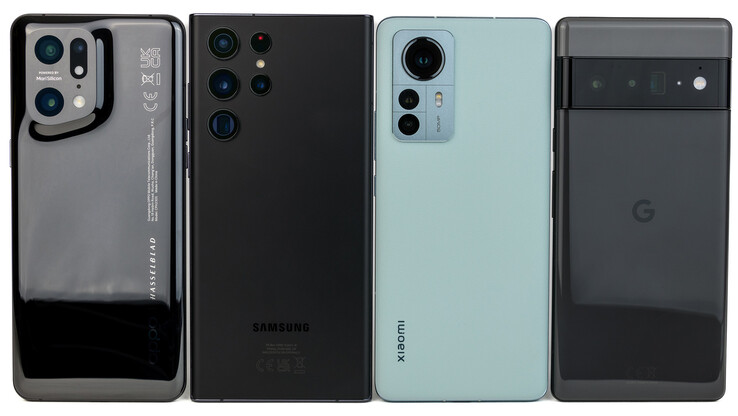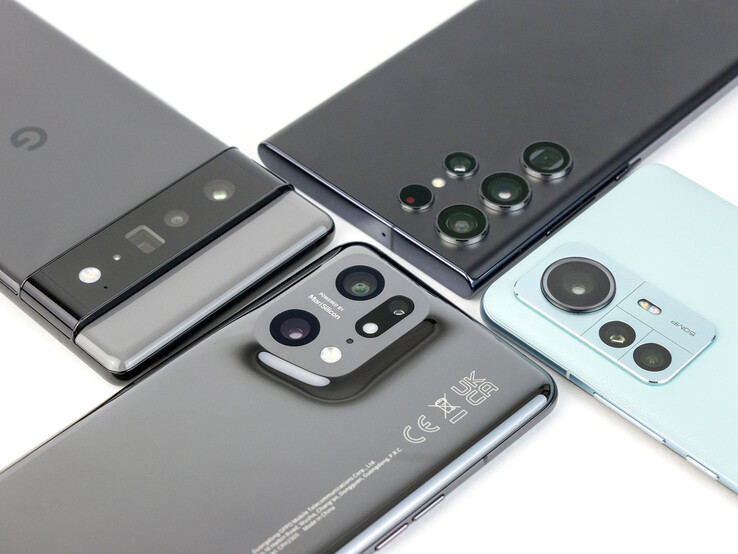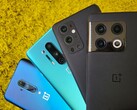Camera comparison: These Android smartphones take the most beautiful pictures
In November of last year, the current creme of the Android smartphones had to compete against the iPhone 13 Pro in our camera comparison test. Since then, all of the manufacturers revised their top smartphones, and we are now comparing them here.
With the Galaxy S22 Ultra, Samsung only performs some minor product maintenance in terms of the camera, using an almost identical setup on the spec sheet. The specifications of the nominal focal length were slightly adjusted, and the HM3 sensor is supposed to be further optimized. In terms of the technology, the Samsung smartphone uses top equipment, offering auto-focus for all the lenses and optical image stabilizing (OIS) for most of them with the ultrawide angle lens as the only exception.
In the Find X5 Pro, Oppo also uses the same sensors as last year, but for the first time, it integrates its own imaging NPU, the MariSilicon X. In addition, more glass lens elements are used, the image stabilization now operates together with a three-axis sensor shift and a two-axis OIS, and the color management was optimized in cooperation with Hasselblad. While the Oppo smartphone is unable to deny its close resemblance to the OnePlus 10 Pro on the spec sheet, it distinguishes itself from the more affordable OnePlus product by the additional features listed above.
In contrast, the camera was completely reworked in the Xiaomi 12 Pro. Although the main sensor continues to offer a 50-MP resolution, it now uses the larger Sony IMX707 sensor. The sensor from last year can now be found in the tele lens as well as the ultrawide angle lens. Unfortunately, Xiaomi did not use the opportunity to add a macro function to one of the lenses.
The Google Pixel 6 Pro also offers a 50-MP main camera, which is probably the Samsung ISOCELL GN1. In addition, there is a ultrawide angle lens and a zoom lens with 4x optical zoom. Google also doesn't offer a macro option.
The prices of the four Android smartphones are fairly close together, with the Pixel smartphone being the only one that starts at significantly less than 1000 Euros (~$1050). In our comparison test, all the candidates use the most current software (see comparison table) and run with AI support activated, using the integrated camera app.
| Google Pixel 6 Pro | Oppo Find X5 Pro | Samsung Galaxy S22 Ultra | Xiaomi 12 Pro | |
|---|---|---|---|---|
| Main Camera | 50 MP (f/1.85, 25 mm, 1/1.31", 1.2 µm, OIS) | 50 MP (Sony IMX766, f/1.7, 1/1.56", PDAF, OIS) | 108 MP (Samsung HM3, 24 mm, 0.8 µm, f/1.8, OIS) | 50 MP (Sony IMX706, f/1.9, 24 mm, 1/1.28", 1.22 µm, OIS) |
| Ultrawide Angle | 12 MP (f/2.2, 17 mm, 114°, 1.25 µm) | 50 MP (Sony IMX766, f/2.2, PDAF, 110,3°) | 12 MP (120°, 1.4 µm, f/2.2, DPAF) | 50 MP (Samsung S5KJN1, 115˚, f/2.2) |
| Tele Lens | 48 MP (4x opt. zoom, up to 20x digital, 104 mm, f/3.5, 1/2", 0.8 µm, OIS) | 13 MP (2x opt. zoom, up to 20x digital, f/2.4) | 10 MP (3x opt. zoom, 70 mm, 1.12 µm, f/2.4, OIS, DPAF) + 10 MP (10x opt. zoom, 230 mm, 1.12 µm, f/4.9, OIS, DPAF), up to 100x digital | 50 MP (Samsung S5KJN1, 2x opt. zoom, up to 20x digital, f/1.9, 48 mm) |
| Macro | - | see ultrawide angle | see ultrawide angle | - |
| RAW Mode | yes (10 bit) | yes (10 bit) | yes (10 bit) | yes (10 bit) |
| Front Lens | 11.1 MP (f/2.2) | 32 MP (Sony IMX709, f/2.4) | 40 MP (f/2.2, AF) | 32 MP (f/2.45, 26 mm) |
| Software Version | SP2A.220405.004 | CPH2305_11_A.17 | SP1A.210812.016.S908BXXU1AVDA | MIUI 13.0.30.0 |
| Price | from 899 Euro (~$944) | 1299 Euro (~$1364) | from 1249 Euro (~$1312) | from 1050 Euro (~$1103) |
Close Ups - Find X5 Pro now without a microscope
Oppo cut the microscope camera from the Find X5 Pro. To make up for this, the ultrawide angle lens can now be used for macro recordings. The Galaxy S22 Ultra also uses this option. Google doesn't offer the option, which can possibly be traced back to the older sensor. With Xiaomi, this lack seems to be purposeful, and this function will probably remain reserved for the coming Ultra model.
This means that those who like to take some macro recordings will be better served by the smartphones from Oppo and Samsung, since those can come significantly closer to the object. The quality of the recording is attractive for both of them. However, Samsung succeeds in drawing better contours, which brings out the stainless steel surface in the picture of the fork better but looks slightly over-sharpened in the picture of the Kiwi. Oppo is unable to make full use of the high resolution of the sensor in macro recordings, since the mode is unavailable with active 50-MP resolution.
Image comparison
Choose a scene and navigate within the first image. One click changes the position on touchscreens. One click on the zoomed-in image opens the original in a new window. The first image shows the scaled photograph of the test device.
KiwiForkMicrophone ScreenUltrawide Angle - Only a single smartphone disappoints
In the ultrawide angle recordings, two 12-MP compete against two 50-MP sensors. On paper, the Find X5 Pro has the most powerful lens, and it is also able to confirm this in our comparison. In the city picture, the Oppo smartphone convinces with a good depth sharpness and high dynamics. The pictures of the other three also look good but are significantly blurrier. This was particularly surprising with the Xiaomi 12 Pro.
The picture of the church looks quite good with all four smartphones, but surprisingly the Oppo shows a fairly high basic noise level as becomes particularly noticeable negatively in the structure of the roof. Xiaomi, on the other hand, exaggerates the contrast, causing edges to appear unnecessarily hard.
In the dark, the Pixel 6 Pro surprises with an attractively brightened recording, while the Find X5 Pro succeeds in taking the most natural picture. Samsung takes a similar path as Google, but the contours become very blurry, while the Xiaomi picture turns out very dark.
Image comparison
Choose a scene and navigate within the first image. One click changes the position on touchscreens. One click on the zoomed-in image opens the original in a new window. The first image shows the scaled photograph of the test device.
CityChurchChurch Low LightZoom - A powerful performance of the Pixel 6 Pro
In the lower zoom levels, all four competitors deliver good results. However, they each show different characteristics, particularly in the areas of the white balance, dynamics, and contrast. While the Oppo offers a very warm reproduction, the Xiaomi stands out with pictures that are rich in contrast but show little dynamics. On the other hand, Samsung exaggerates with this a bit, causing the contours to become slightly blurry in the edge areas, which can result in some smaller burnt-out spots in lighter areas in the background. Those can hardly be noticed at all in the Pixel. Indeed, the Google smartphone offers the most constant reproduction performance in this zoom range.
For 5x zoom, all the models have to use a hybrid or digital zoom, and the differences become larger here. Particularly the Pixel still delivers a good quality reproduction, and the 12 Pro is on the other end. The Find X5 Pro is slightly less sharp than the Google smartphone. We used the 108-MP mode in the Samsung Galaxy S22 Ultra, which also allows 6x zoom, but the results aren't very attractive. So it is better to leave the smaller image format, but even then, the image result of the Samsung is worse than that of the Oppo, since the edges then become fairly blurry.
In this area, the S22 Ultra stands out with its 10x optical zoom, while we already see some noticeable quality loss in all the competitors. In the 20x zoom, the Pixel 6 Pro surprises with a powerful imaging performance. The Samsung is also still quite good here but shows a darker reproduction. However, the S22 Ultra is the only smartphone in our comparison field that additionally supports a zoom level up to 100x and also offers by far the best image stabilization.
Those who want to use zoom in weak light conditions have to be prepared to accept significant drops in the quality with all the models.
Both the Find X5 Pro as well as the Samsung smartphone use an additional electronic viewfinder with long focal lengths. This occurs from a 15x or 20x zoom level respectively.
Image comparison
Choose a scene and navigate within the first image. One click changes the position on touchscreens. One click on the zoomed-in image opens the original in a new window. The first image shows the scaled photograph of the test device.
5x zoom10x zoom20x zoom5x zoom low lightMain sensor - A lot of it is a matter of taste
The main cameras of all four smartphones allow you to take good pictures. All of them use image algorithms that are supposed to get the optimum from every recording. While Google uses the most natural white balance, the other three prefer a warmer reproduction. In addition, Samsung and Xiaomi sharpen the images more than the competitors. Particularly the lake image shows that the Find X5 Pro and the 12 Pro suggest the least dynamic range. In daylight, a lot will surely depend on your own tastes.
The same goes for the low-light recordings. There are no real outliers to the top or bottom. While none of the pictures are ready for printing, they are attractive for social media and on the display with an atmospheric lighting. Particularly the Oppo has the least burnt-out spots with bright image areas, but it also tends toward a very warm white balance. On the other hand, the Google and Xiaomi smartphones offer a cooler reproduction, also capturing the more realistic colors.
Image comparison
Choose a scene and navigate within the first image. One click changes the position on touchscreens. One click on the zoomed-in image opens the original in a new window. The first image shows the scaled photograph of the test device.
BunnyLakeBunny Low LightStreet Low LightPath Low LightSelfies - Mirror, mirror in the hand…
We took the selfies using the default settings, also always holding the phone in the same hand to show which of the smartphone flips or doesn't flip the pictures. However, all the smartphones allow you to change this in the settings.
In daylight, all the smartphones succeed in taking attractive pictures, with the Xiaomi using a strong beauty filter by default. However, you can also turn this off or adjust this.
In portrait mode, the differences become more pronounced. Only the Galaxy S22 Ultra and Pixel 6 Pro succeed in maintaining the HDR function. With the two other phones, the sky in the background looks burnt out.
As soon as the light becomes weaker, the Oppo and Samsung move slightly ahead of the competitors. While the picture from the Pixel 6 is slightly blurry, that of the Xiaomi 12 Pro appears very pale and murky.
Verdict - More expensive doesn't always mean better
The top Android smartphones continue to be very close in terms of their imaging performance this year as well. With the main camera, primarily personal preferences surely play an important role. Things look different with the additional lenses, where there are not only equipment differences but also visible quality differences, with the more expensive models not necessarily being the better ones.
None of the Android smartphones is clearly able to stand out from the competitors, but there are still some noticeable differences.
The most extensive overall package is surely offered by the Samsung Galaxy S22 Ultra, covering everything from macro recordings up to a 100x digital zoom. In terms of the quality, the smartphone also offers an attractive imaging performance throughout, but it still isn't the top in all areas.
With its many new changes, the Oppo Find X5 Pro is able to catch up, offering probably the best ultrawide angle lens. When zooming, 20x is the limit. While there would surely be some room for improvement here, Oppo still offers an attractive overall package.
We are positively surprised by the most affordable Android smartphone in our comparison field, the Google Pixel 6 Pro. The pictures impress us with a very balanced image composition and natural colors. Particularly the zoom is still really good even at the maximum 20x level, although you then need to support the phone. The ultrawide angle lens is rather mediocre.
We see the Xiaomi 12 Pro as slightly behind the competitors. The main camera takes pictures that are saturated and rich in contrast - this is probably a matter of taste. However, we would have expected a bit more from the zoom as well as the ultrawide angle lens.
No matter which of these smartphones you choose, good pictures and many options are guaranteed. However, each of the smartphones emphasizes a different area, and we see none of the competitors as a real jack-of-all-trades.




















